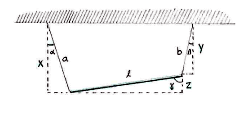Solution 4.2:8
From Förberedande kurs i matematik 1
(Difference between revisions)
m |
|||
| (3 intermediate revisions not shown.) | |||
| Line 1: | Line 1: | ||
| - | + | We start by drawing three auxiliary triangles, and calling the three vertical sides ''x'', ''y'' and ''z'', as shown in the figure. | |
| - | + | ||
| - | + | ||
| - | + | ||
| - | + | ||
| - | + | ||
| + | [[Image:4_2_8.gif|center]] | ||
| - | [ | + | Using the definition of cosine, we can work out ''x'' and ''y'' from |
| + | |||
| + | {{Displayed math||<math>\begin{align} | ||
| + | x &= a\cos \alpha\,,\\[3pt] | ||
| + | y &= b\cos \beta\,, | ||
| + | \end{align}</math>}} | ||
| + | |||
| + | and, for the same reason, we know that ''z'' satisfies the relation | ||
| + | |||
| + | {{Displayed math||<math>z=\ell\cos \gamma\,\textrm{.}</math>}} | ||
| + | |||
| + | In addition, we know that the lengths ''x'', ''y'' and ''z'' satisfy the equality | ||
| + | |||
| + | {{Displayed math||<math>z=x-y\,\textrm{.}</math>}} | ||
| + | |||
| + | If we substitute in the expressions for ''x'', ''y'' and ''z'', we obtain the trigonometric equation | ||
| + | |||
| + | {{Displayed math||<math>\ell\cos \gamma = a\cos \alpha -b\cos \beta\,\textrm{,}</math>}} | ||
| + | |||
| + | where <math>\gamma </math> is the only unknown. | ||
Current revision
We start by drawing three auxiliary triangles, and calling the three vertical sides x, y and z, as shown in the figure.
Using the definition of cosine, we can work out x and y from
| \displaystyle \begin{align}
x &= a\cos \alpha\,,\\[3pt] y &= b\cos \beta\,, \end{align} |
and, for the same reason, we know that z satisfies the relation
| \displaystyle z=\ell\cos \gamma\,\textrm{.} |
In addition, we know that the lengths x, y and z satisfy the equality
| \displaystyle z=x-y\,\textrm{.} |
If we substitute in the expressions for x, y and z, we obtain the trigonometric equation
| \displaystyle \ell\cos \gamma = a\cos \alpha -b\cos \beta\,\textrm{,} |
where \displaystyle \gamma is the only unknown.

